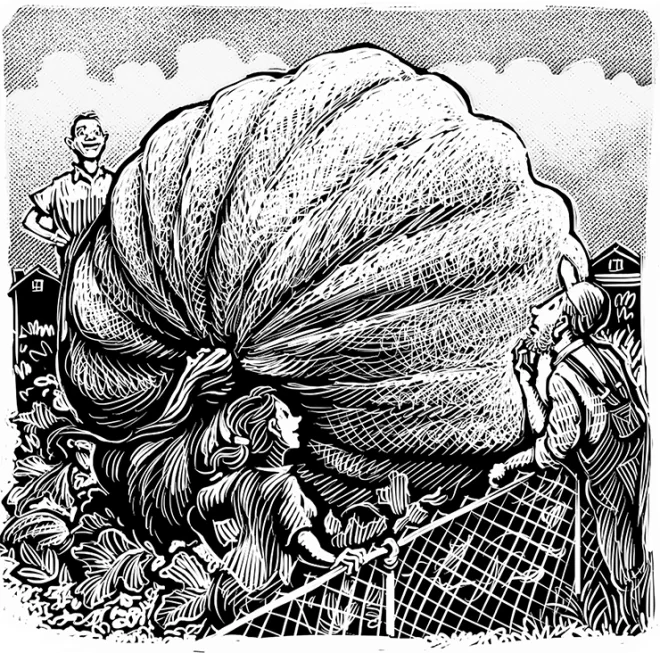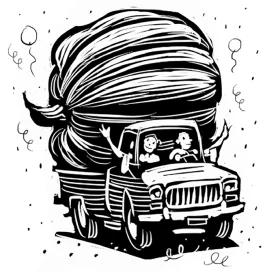
It all started when my newly minted husband, Paul, and I bought our first house. We stood on the back porch, surveying our empty yard. There were no trees, no bushes, no flowers—just a wide expanse of grass. I then uttered the fateful words: “We need to plant a garden.”
Soon my sweating spouse was engrossed in removing the sod from about half the backyard so we could prepare it for our garden. It was Fall in Seattle, but we were eager to get started. That Friday, while reading the local paper, I said, “Honey, there’s a big yard sale tomorrow, and it has a couple of rototillers for sale. Think we ought to go?”
Paul’s eyes lit up. “Let’s be the first ones there!” he said.
We visited the cash machine, plotted the sale’s location, and set out early the next morning. We were, indeed, first in line. And the first things we noticed behind the fence were two rototillers, in all their shiny-red glory. I raced to the small one, while Paul zoomed in on the big one.
“How much is this big tiller?” he asked the owner. Paul was worried that we couldn’t afford it—it was a nearly new Troy-Bilt!
The seller said, “Oh, how about $100?” “Are you sure?” My sweetie was so excited he fumbled with his wallet.
“Yeah. I just want it out of here.”
I asked about the small tiller and was told I could have it for $30. We paid up—quickly—and loaded the tillers onto our truck, almost giddy with excitement. We had just scored about $1500 worth of rototillers for $130!
You won’t be surprised to hear that we cranked up both ma-chines as soon as we got home—and that our garden plot ended up much larger than we had planned. “Oh, well,” Paul said after-wards, “if a little is good, a lot has to be better!”
The next weekend, we attended a Fall festival at a local produce farm. They were having a giant pumpkin weigh-off.
“Good golly, look at the size of those things!” I said.
“I heard they feed them milk,” Paul added.
We were staring at an 800-pounder (its sign said), and the owner was cutting a big hole in it. He reached in up to his shoulder, pulled out a handful of huge pumpkin seeds—and gave them to us!
“Here, now you can grow one and bring it next year,” he told us.
We thanked the man and pocketed the enormous seeds. Then we wandered over to a booth for the Pacific Northwest Giant Pumpkin Growers Association.
“Maybe we better find out how to grow these giants,” my husband said. I agreed. We ended up joining the organization and buying an instruction book. They also gave us a membership card and a little brown paper bag.
“What’s in the bag?” I asked.
“Giant pumpkin seeds!” I was told.
We were now in possession of seeds from that 800-pound pumpkin as well as seeds from several recent prizewinning one, including a 1,000-pounder. We were convinced that next year was going to be a banner garden year for us!
When Spring came, we could hardly wait to start planting. We started early with the usual radishes, lettuce, and such, while we waited for warmer weather to plant our giant pumpkins. Follow-ing our book’s instructions, we had started them indoors early.
Finally, the Seattle weather warmed up.
“Do you think today is a good day to plant our pumpkins?” I asked as I leafed through The Old Farmer’s Almanac.
“Let’s do it!” Paul said. Shovels in hand we created three good-size mounds, amended them with two burlap bags of elephant poop from a visiting circus, and added our healthy plants. We watered them in well. Now we just had to wait.
It wasn’t long before the vines started growing. And grow-ing. And growing! They soon covered the space allotted to them and were rapidly covering the radishes and lettuce—and heading for the beans and corn.
“Do these things ever stop?” I asked.
“I am not seeing any blooms or little pumpkins,” Paul said. He was buried knee-deep in vines, looking under leaves that were two feet across. We decided to check our manual and found that we needed to cut off the growing tips of the vines to stop them and encourage blooms. Considering that the vines now covered almost our entire backyard, it was definitely a good idea.
A couple of weeks later, I heard, “They’re blooming!” from the backyard. We had blooms—but they were all male. It turns out, our manual said, that female flowers take another week or two to bloom. We were planning to hand-pollinate the flowers (got to keep our prizewinners pure!) and not leave it to the bees. After we played Cupid and bagged the pollinated flowers, we had to wait some more. Soon we noticed tiny pumpkins swelling. They grew fast. I mean, these babies were doubling in size overnight!
Our neighbor came over and scratched his scruffy beard. “I can’t believe it,” he said. “Man, those things can grow!”
In two months, we had pumpkins the size of washtubs—and they were still growing. We covered the ground with straw to make comfortable beds for them. We watered and fertilized. We found instructions for estimating their weights by measuring across the pumpkins.
Now we had to remove all but the fastest-growing pumpkin on each vine. “I sure hate to do this,” Paul said.
“I know” I said. “Me, too, but it’s the only way we are going to get a really big one. These must be at least 100 pounds apiece already!”
We duly removed seven big pumpkins, leaving only the three biggest ones, one per vine. This was hard for two novice giant pumpkin growers. Now we had to wait some more.
In August, one of the remaining three stopped growing at around 200 pounds. The other two were gaining about ten or more pounds every night! Every morning, there was measurable growth—a lot of it. We’d never seen anything like these monsters.
“Those things look absolutely prehistoric,” our beard-scratching neighbor commented.
We were sure we were closing in on a prizewinner. We had no idea what they weighed, only that they were so big that moving them would be a problem. “Leave it to me,” my husband assured me. “I’ll call my guys.”
Soon six big, burly men were standing in the vines, scratching their heads, looking at the giant pumpkins. “Holy moley, you guys grew these things?” one of them said.
“They gotta weigh a ton!” another commented.
Soon they were rolling one of the pumpkins onto a big tarp and then dragging it to our truck. It filled the back of the pickup.
“What’re you gonna do with it now?” they asked.
“We are taking it to the big giant pumpkin weigh-off up in Duvall,” Paul said. “You want to join us?”
“Naw,” they answered, grinning. “Then you’d want us to unload it, too!”
We thanked them for their help, jumped in the truck, and headed off.
All the way on the road, cars were honking at us, people were waving, and some were taking pictures. Everyone loved our giant pumpkin.
“Think it’s a winner?” I asked Paul.
“Oh, I don’t know,” he answered modestly. “There were some enormous ones there last year.” I could tell by the gleam in his eyes, though, that he had high hopes. So did I.
When we reach the weigh-off, we were welcomed by the other growers. We parked and registered, waiting for the forklift to un-load our giant. We couldn’t help noticing, however, that compared to the other pumpkins, ours wasn’t quite as giant as we thought. Apparently, filling the back of a pickup truck isn’t enough.
Sure enough, when our turn came and our baby was gently set on the huge scale…
“697 pounds!” The announcer cried.
We were crestfallen—we’d been sure our pumpkin was at least 800 pounds. But we were still proud of our big baby.

The winner was over 1,600 pounds and came in on a flatbed truck. We would really have to up our game next year. In fact, we had the smallest giant pumpkin at the event. We did receive the prize for “Valiant First Effort.”
We went up to accept our prize, which was in a brown paper bag.
“What’s in the bag?” I asked Paul excitedly.
He looked at me with a grin and said, “Giant pumpkin seeds!” ❖


 Previous
Previous

